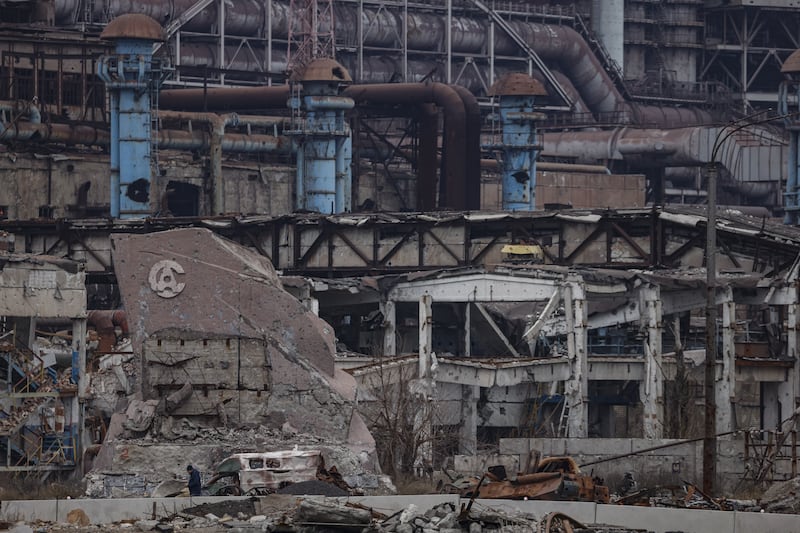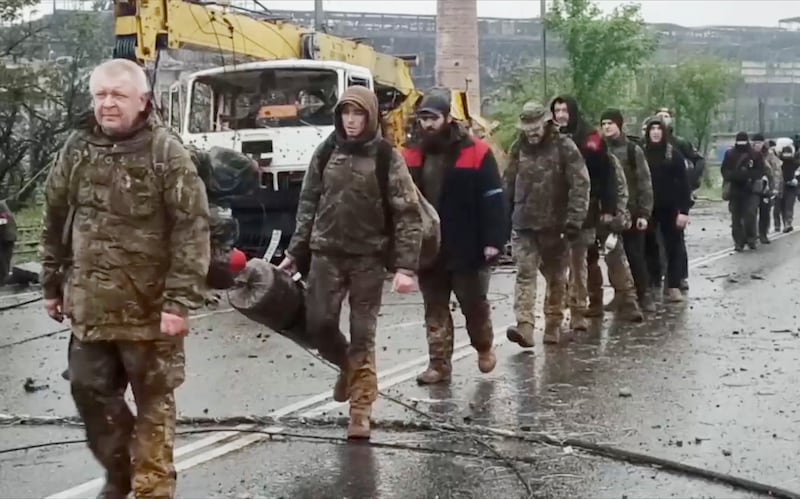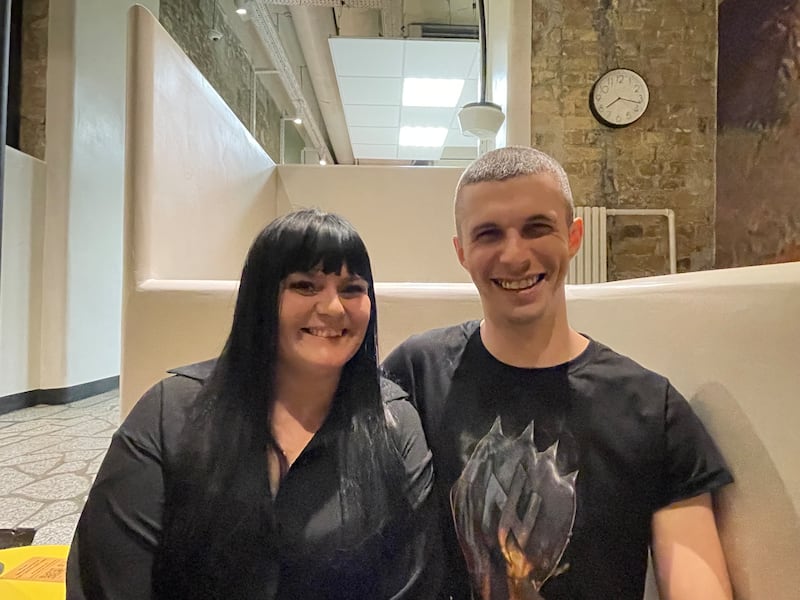News of the Kremlin’s all-out invasion of Ukraine found Oleh Anisimov on a night train heading east to Mariupol, just as Russian troops pushed west with the strategic port city in their sights.
What began as a simple journey home after visiting his girlfriend Olha would lead Anisimov into bloody street fighting with Moscow’s troops, then a desperate seven-week siege inside the sprawling Azovstal steelworks and finally four months in the hands of Russian captors who he says tortured their prisoners “for fun”.
“When the train reached Mariupol I went home and woke my mum and told her war had begun. Then I got my uniform, body armour, helmet and other gear and called my friends, and we all went to sign up with the territorial defence force,” Anisimov (28) recalls.
He had already fought Russian-led militia in eastern Ukraine – where Mariupol on the Azov Sea is the main port – but left the army shortly before February 24th, when the Kremlin revealed ambitions that went far beyond de facto control of parts of Donetsk and Luhansk regions.
READ MORE
Anisimov’s volunteer unit clashed with the Russians just outside Mariupol but was gradually pushed back towards the city centre. When he was in a reconnaissance group scoping for positions, a shell exploded nearby and hurled shrapnel into his chest.
“It hurt but because of the adrenalin I didn’t feel too much. I thought it was a light wound, but only much later did I find out that a piece of shrapnel had pierced my lung and lodged near my liver. It’s still there now,” he says.

On March 20th, the injured Anisimov retreated with his comrades into Azovstal, where some 2,000 Ukrainian fighters from various units gathered to make a last stand for Mariupol, and hundreds of civilians sought refuge in labyrinthine tunnels and bunkers.
“Already in April medical supplies were running low. I spent a week in the field hospital [inside Azovstal] and had to do without painkillers because there were other guys there who had lost limbs,” Anisimov says. “There was a shortage of antibiotics too. And each day there was less food to eat and we had to drink water from the heating pipes.”
As conditions in Azovstal worsened, Russia’s military pounded the factory-turned-fortress from land, sea and air and its soldiers tried to storm the vast complex, while Ukrainian troops including Anisimov kept watch over approaches to the plant.
“I’d never been under such intense shelling, so it was quite shocking and scary. They were hitting us from all sides with an incredible amount of firepower,” he says.
[ Fighting for Ukraine: ‘I wasn’t sure that we could hold out and defend Kyiv’Opens in new window ]
Helicopter pilots undertook extraordinary – and sometimes fatal – missions to deliver supplies to Azovstal and evacuate the most badly wounded troops, but an operation to break the siege was unfeasible when Ukraine’s forces were stuck 100km away and lacked sufficient attack aircraft and long-range missile systems.
“Basically we were prepared to die, because the frontline was so far away and it would have cost tens of thousands of lives to save us. And there weren’t so many of us there to risk that many soldiers. So we thought we’d probably be killed,” Anisimov says.

Instead, Kyiv eventually ordered the defenders of Azovstal to leave the ruined complex after they had tied up significant Russian forces in Mariupol for nearly three months, and on May 18th it was Anisimov’s turn to walk out of the factory and into captivity.
He was held for a week in Olenivka in occupied Donetsk region, before being transferred with other Ukrainian soldiers to Taganrog, a city 100km east of Mariupol on Russia’s Azov Sea coast.
“In Olenivka they didn’t touch us but in Taganrog they basically beat us every day ... For the first few days they questioned me. After that they just beat us for fun,” Anisimov says.
He remembers the guards torturing prisoners with an electric shock baton, rubber truncheons and a large wooden mallet and says they sometimes put him in handcuffs and hung him from them “for about two hours”.
“The last time they did that was May 27th or 28th. May 27th is my birthday, and they knew that. I hope the marks will fade with time,” he says, showing the scars that still ring both his wrists more than six months on.
“They did nothing to treat my chest injury, gave us just enough food so we didn’t starve and allowed us to shower once a week,” recalls Anisimov, who lost 20kg in captivity.
He and the four other Ukrainians in his cell “went through bad moments, of course, when everything seemed bleak, but we supported each other.”
He recalls how the jailers tried to demoralise them by claiming Russian troops had seized much of Ukraine and big cities such as Kharkiv, Dnipro and Odesa, and how they believed Kremlin claims about “Nazis” persecuting Russian speakers in Ukraine.
“They really believe they’re fighting fascists. And they said Poland had taken over part of western Ukraine and lots of other nonsense. I don’t know what was going on in their heads: lots of us [prisoners] – nearly all of us – were Russian speakers. So for them it was confusing, it messed with their heads, but they said we were fascists all the same.”

Anisimov always thought that eventually he and his fellow prisoners would be exchanged, but when they were taken, handcuffed and blindfolded, to a plane on September 21st, he thought they were being flown to another Russian jail. From the plane they travelled further on a bus, and when the bus stopped a man climbed aboard and greeted them with “Slava Ukraini!” – “Glory to Ukraine!”. Then he checked each of their names on a list and told them they should get off the bus and walk on.
They were at the Belarus-Ukraine border, and were being freed in a surprise deal to swap more than 200 Ukrainian soldiers for 55 captured Russians and pro-Kremlin Ukrainian figures including oligarch Viktor Medvedchuk, a friend of Russia’s leader Vladimir Putin who faced treason charges in Kyiv.
“I started shaking and chain-smoked more than a whole pack of cigarettes in about an hour just to calm down. I found the guys who I fought beside in Mariupol and the emotions were just amazing – the joy is impossible to describe,” Anisimov says.

To the east in Donetsk region, Olha was with her military unit when a colleague told her that her husband had just been released and that perhaps Oleh was free too. So she went to the place at their position where there was a good mobile signal, and waited.
“After 20 minutes I got a call from an unknown number. I thought it must be him, and it was. There were tears and screams, because I was hysterically happy,” she says now, sitting beside her husband in a Kyiv cafe on a snowy December evening.
“We were told that they may need time to readapt after being in captivity. But I knew he was a resilient person and wouldn’t change – and he hasn’t changed,” Olha says.
They met a year-and-a-half ago in New York – a frontline village in Donetsk region – and were apart for seven months between Anisimov’s departure on the night train to Mariupol and his return from Russia. Last month they got married in her hometown of Khmelnytskyi.
His hometown now lies devastated and under Russian occupation, with most of its pre-war residents displaced or dead.
“I just want Mariupol to be Ukrainian again,” he says, “and we’ll rebuild everything later.”






















